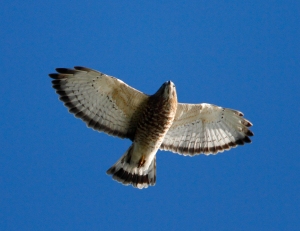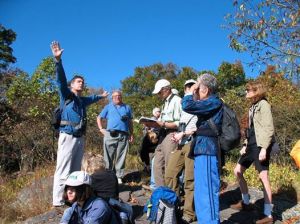Two Broad-winged Hawks soared along the eastern side of the mountain, then around to the south to head west. They reached such a height that we had to shield our eyes from the mid-morning sun. “Look for the white narrow bands on their tails,” more than one person remarked. The bands were a strong clue which birders use to identify Broad-wings while hawkwatching, besides observing the flight style. These raptors were our first for the day. Some took it as a good sign for later.

Photo of a Broad-winged Hawk, courtesy of Steve Sachs. https://www.facebook.com/pages/STEVE-SACHS-PHOTOGRAPHY/117329904967633
Sixteen of us stood on the bare rocks, scanning the sky our binoculars and scopes, or simply looking around with binoculars ready at hand. The sky was mostly clear, an intangible blue. Small clouds took shape all around us, far away enough to not interfere. In the south-east large cumulous clouds formed. A weak haze grayed the towns beneath us. And due south, the Tappan-Zee Bridge stretched across the Hudson River.
I didn’t know what to expect for my first hawkwatch. I only read about how difficult this kind of birding was. Raptors, at quite a distance away, were hard to see, hard to identify by species, hard to make out their age/sex, etc even with good equipment. I expected I’d be terrible. I had never seen any pictures of hawkwatchers, so I imagined that all of us eventually laying on the ground (to spare our necks from getting stuck in the look-up position), holding heavy 10x binoculars (at least 10x) or looking through scopes, and constantly narrowing our eyes just so that we could barely make out that those dark pinpoints – hundreds of feet away – might be hawks or vultures or whatever.
We paused when we nearly reached the top of the mountain. Charlie Roberto – an avid naturalist who led the hike up and exposed to us salamanders from underneath rotted logs – took the chance to talk about the raptors we might see and briefly describe the clues that indicate which is which. When he finished, everyone laughed – it was simply too much information in less than five minutes. As I knew I’d be overwhelmed as well. I don’t think anyone noticed that I tuned out mi-speech.

Charlie Roberto demonstrating the flight of a Turkey Vulture. I’m the only person sitting. © William Kellner
About half-an-hour after we began our hawkwatching, we noticed a speck string of Broad-Wings soaring to the south-east. Some went in twos or threes. Others flew individually, keeping their distance from the ones behind and in front of them, up to a hundred feet. My binoculars (borrowed) were 8×42 Vortex Diamondback, a good pair for hawkwatching, according to Charlie, but right then I wished I owned a scope. The Broad-Wings were practically dots. Against the blue, they vanished. Then they reappeared, in full silhouette, as they flew in front of the clouds, a relief not just for me but for everyone. To our excitement, when we reached right of the cumulus clouds, we saw that the Broad-wings had formed a kettle.
While migrating, raptors use thermals – warm columns of rising air – whenever they can to conserve energy as they travel from as far up as Northern Canada to as far down as Argentina. They begin circling, slowly rising, rising, as if being stirred in boiling water in a pot. Hence, kettles. Depending, only one species forms a kettle. Or, there are multiple species, sometimes with a small group joining a larger. The number of raptors ranges from the double digits to the ten thousands. While birding in Costa Rica one April, Christine McClusky (who was in our group that day) said to me that she watched a line of thousands and thousands of migrating Broadwings. Quite a distance from them, she initially thought she saw was a thin cloud.
Our kettle only contained Broad-wings. It took the form of a broad tornado filled with scattered, methodically floating leaves, with each raptor soaring at its own pace. I didn’t bother counting how many there were myself – I’d never seen such a high concentration in one spot, and they kept moving. Goodness knows I’d mess up every time I reached ten. How can someone earn money from this? So much for having a hawk counting job at the Cape May Observatory. Two experienced, with scopes, agreed to having counted a little over two hundred. (They didn’t submit the eBird list I linked at the end of this post,) Even if I had already known that as many as ten thousand raptors could form a kettle, I would still be transfixed by this particular one before me. It presented a question: How did they teach themselves to do this? I asked how high the Broad-wings were. No one could give me an estimate.
I had to look away for my neck’s sake. I hadn’t keep track of the time, so I can’t remember exactly how long the kettle lasted, or when it finally dispersed or moved on.
No more kettles after that. But our hawkwatching wasn’t any less enjoyable. We mostly looked to the north and northwest. A few more Broad-wings flew by themselves or in twos or threes. Also going by were Red-tailed Hawks, Sharp-shinned Hawks, several Ospreys, one Cooper’s Hawk, and a couple young Bald Eagles (whose plumage is mostly brown with white patches). One of the birders with a scope spotted a Peregrine under a Broad-wing. Hoping to finally get a good look of this falcon, I scanned for it carefully. Blue. Still blue. And all the other the raptors soaring about. I heard everyone else exclaiming, “Found it!” Frustrated, I lightly cursed at the Peregrine. Well, this instance was bound to have happened at least once. Nonetheless, I didn’t add the bird to my eBird list.
Throughout the hawkwatch, Turkey and Black Vultures glided around the side of the mountain. Imposing statures. Darkly elegant. Their wingspans are nearly as long as those of Bald Eagles. The Turkey Vultures came near enough for us to see the lines on their red faces – which looked badly burned and raw skin – without binoculars. Most of the group paid them little to no attention. The rest, including myself, kept watched whenever they came into view. Never had we seen them so closely.
During the lulls, I sometimes kept my eye on the owl figure, which was stuck at the end of an erected twenty-foot pole. Placed near the rocks on which we stood, it was supposed to fool raptors into flying closer to the mountain and give birders a good look. For the first couple hours nothing took the bait. Then, as if a part of the birders’ sacrifice, half of our group departed. Minutes after, a Sharpie – an accipiter smaller than a crow and certainly smaller than that owl – went for the attack. But, in a flash, it realized its enemy was a fake within inches. It flew away.
A moment later, the owl attracted two Red-tails. They only checked it out, but that didn’t deprive us of a great view. They circled less than twenty-feet above our heads. I could see individual feathers on their breasts, dark streaks on soft white.
After two-and-a-half hours, I had to leave. Before I reached the trail that took me into the woods, I caught a glimpse of a Turkey Vulture soaring down the mountain. It swiftly disappeared behind the trees.